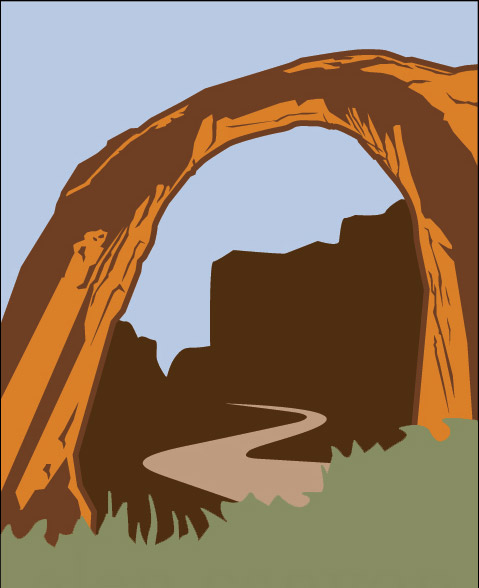
glen canyon instituteDedicated to the restoration of Glen Canyon and a free flowing Colorado River.
GCI
Creating a Vehicle for Action
By Dave Wegner, Science Director
January 1999
The Colorado River and the sculptured canyons of the Colorado Plateau: imagine the awe, wonder, and fear that Major Powell and others felt when they floated through them for the first time. I often wonder what the Major would think to see Glen Canyon drowned by a stagnant body of water bearing his name – a reservoir that serves as the political bathtub for the upper basin and the personal playground for jet skis and powerboats.
In July Glen Canyon Institute conducted a natural history, education, and discussion raft trip down the Green and Colorado Rivers through Stillwater, Labyrinth, and Cataract Canyons. Gazing at the towering rock walls, listening to the quiet of the river on the calm stretches and the power of the river in the rapids, it was easy to picture the environment that Powell explored in 1869. I found it especially exhilarating to contemplate the immense opportunity that Glen Canyon Institute has with our proposal to restore Glen Canyon.
The Institute is focusing on many issues as we develop our strategy for the next two years. These components include technical and National Environmental Policy Act (NEPA) documents, educational development, political action, and legal applications.
One of the critical technical elements is the development of the Citizens Environmental Assessment (CEA) for the Restoration of Glen Canyon. The CEA is the innovative and focused approach we have selected to move the proposal from words to action.
Our development of the CEA has generated a great deal of interest. Let’s take a few minutes and address some of the questions that people have been asking.
Why a CEA? Since the dam is a federal facility, we must initiate a federal action in order to restore the Colorado River through Glen Canyon. We plan to develop a scientifically supportable document, a CEA, as a first step. The Institute’s objective is to get the government to respond to the citizens’ request and initiate an environmental impact statement on the proposal.
Congressman Hanson of Utah defined this approach for us at a September 1997 Congressional hearing when he stated that Congress would not act on this proposal unless the public showed enough interest. We believe that the public is interested and willing to support the action.
Our objective is to use the CEA to show that the proposal has merit and is based on sound information and public interest. This is the same logic that was used with the Glen Canyon Environmental Studies, which led to development of the initial environmental impact statement on the operations of Glen Canyon Dam – a comprehensive study showing that long-term ecosystem sustainability for the Colorado River is not possible with the dam in place.
What will be included in the CEA? The assessment will follow guidelines established by the Council of Environmental Quality, and will follow the format of a NEPA environmental assessment. Included will be the proposed action, alternatives to complete the restoration, a review of the technical and economic information, and the costs and benefits of the proposal. Three primary areas will be evaluated:
- Restoring Glen Canyon.
- Restoring and protecting the long-term ecological sustainability of Grand Canyon.
- Safety of Glen Canyon Dam and the variability of water supply and floods in the Colorado River.
What is the status of the CEA? We have developed a written strategy and timeline for the CEA, and the Salt Lake City office is busy raising funds to conduct it. Right now we have identified specific technical studies in sedimentation, hydrology, water quality, economics, hydropower, biology, and recreation that will be contracted out to support the document. Public meetings will be scheduled to provide for discussion, education and recommendations.
How will the CEA be developed? The CEA will be coordinated through the Institute. We will utilize outside experts to help us augment technical information that we already have, and to develop the technical reports necessary to support the CEA. As we develop the full technical study plan, we will assemble a Technical Advisory Panel, who will provide independent review and analysis of the technical reports and overall CEA development.
Is there a precedent for this approach? The United States was founded on the principle of free speech and democracy. We have an intrinsic right to question decisions made by politicians and past actions made by the government. If we had not exercised our right to question past decisions or actions, advances in civil and voting rights and environmental protection would never have come to pass.
Glen Canyon was drowned before we had the ability to publicly question the building of the dam. Must we therefore accept it and condemn the canyon to continued degradation? Do we not have the responsibility to look toward the future environment that our children and their children will inherit?
Congress and the Department of the Interior have been clear; they will do nothing unless the public demands it. The CEA approach utilizes tools that Congress has given us, will include the public, and will be based on the technical information that is available.
Where to from here? During the next few months the Institute will be launching the CEA. Concurrently we will be implementing our educational forums and debates, and expanding our web site.
Every day that goes by brings more people and ideas into this debate. From a small kernel of desire to restore Glen Canyon has emerged a cause and a forum for discussing restoration issues across the country and around the globe.